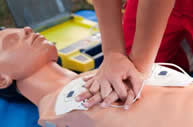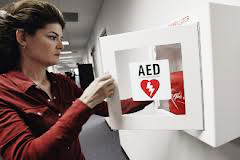AEDs in the Workplace
If a coworker suddenly exhibits signs of a heart attack, their life could be saved by the use of an onsite automated external defibrillator (AED). OSHA data notes that 10,000 cardiac arrests occur per year at work. The use of an AED within 5-7 minutes of an attack can improve survival rates by 60%. For workplaces that do not have an AED program and don’t know where to start, the American Heart Association (AHA) provides an implementation guide:
- Get medical oversight. The Food and Drug Administration (FDA) may require a physician’s prescription to purchase an AED. The responsibilities of the physician may inclu
 de signing off on or making recommendations on training plans and policies and procedures, evaluating data recorded on an AED during a medical emergency and helping assess each use of an AED to recommend any improvements. de signing off on or making recommendations on training plans and policies and procedures, evaluating data recorded on an AED during a medical emergency and helping assess each use of an AED to recommend any improvements.
- Work with local EMS. Most states require you to coordinate your AED program with local EMS and to provide follow-up data to EMS after any use of the AED. In states that require registration or application for AED programs, the physician or program coordinator completes this process. State-specific information is available from the NCSL.
- Choose an AED. The AED you choose should be simple and easy to use. There are several on the market suitable for a company’s AED program. The AHA does not recommend one device over another, but does provide a list of FDA-cleared AED manufacturers.
- Contact technical support. Make sure you have technical support when your AED device requires it. Call the manufacturer’s technical support number and see what kind of response you get. Is a representative available to help you right away? Are you on hold for a long time? Does your call go to voice mail?
- Make sure program support is available. Some AED manufacturers provide help with program implementation and ongoing support. They can assist with placement, medical authorization, registration, training and supplies. Review your capabilities and determine if services like these would be helpful in deploying your AED program.
 Place your AEDs in visible and accessible locations. Effective AED programs are designed to deliver a shock to a victim within 3-5 minutes after the person collapses. Use a three-minute response time as a guideline to help you determine how many AEDs you need and where to place them. Place your AEDs in visible and accessible locations. Effective AED programs are designed to deliver a shock to a victim within 3-5 minutes after the person collapses. Use a three-minute response time as a guideline to help you determine how many AEDs you need and where to place them.
- Develop a training plan. AED users should be trained in CPR and the use of an AED. Training in the use of an AED can help increase the comfort and confidence level of responders. Some companies recruit and train employees as responders. Responders are trained in CPR and the use of an AED so someone is always available to respond to an emergency. The AHA offers CPR AED training in a classroom setting and an eLearning format. The Red Cross also offers CPR/AED training and certification classes in your area.
- Raise awareness of the AED program. Provide information to all employees at your company about the AED program. Use newsletters, posters, magnets, signage or other means to promote your AED program and identify where the devices are located. By continually raising awareness of the program, you reinforce to employees that your organization is committed to their safety.
- Implement an ongoing maintenance routine. It is important to do a weekly or monthly visual inspection of the AEDs to ensure they are in working order. The program coordinator or another designated person can do the inspections. This person develops a written checklist to assess the readiness of the AEDs. Also, talk with your manufacturer regularly to get the latest information about software updates or upgrades. But some problems were due to poor maintenance, such as battery failure, so ensure that an employee is assigned to check the AED on a monthly basis.
The defibrillator industry has recalled some devices due to failure during use, caused by manufacturing. In March 2013, the FDA announced a move to toughen regulation of the defibrillator industry, by more closely monitoring how the AEDs are designed and made.
|